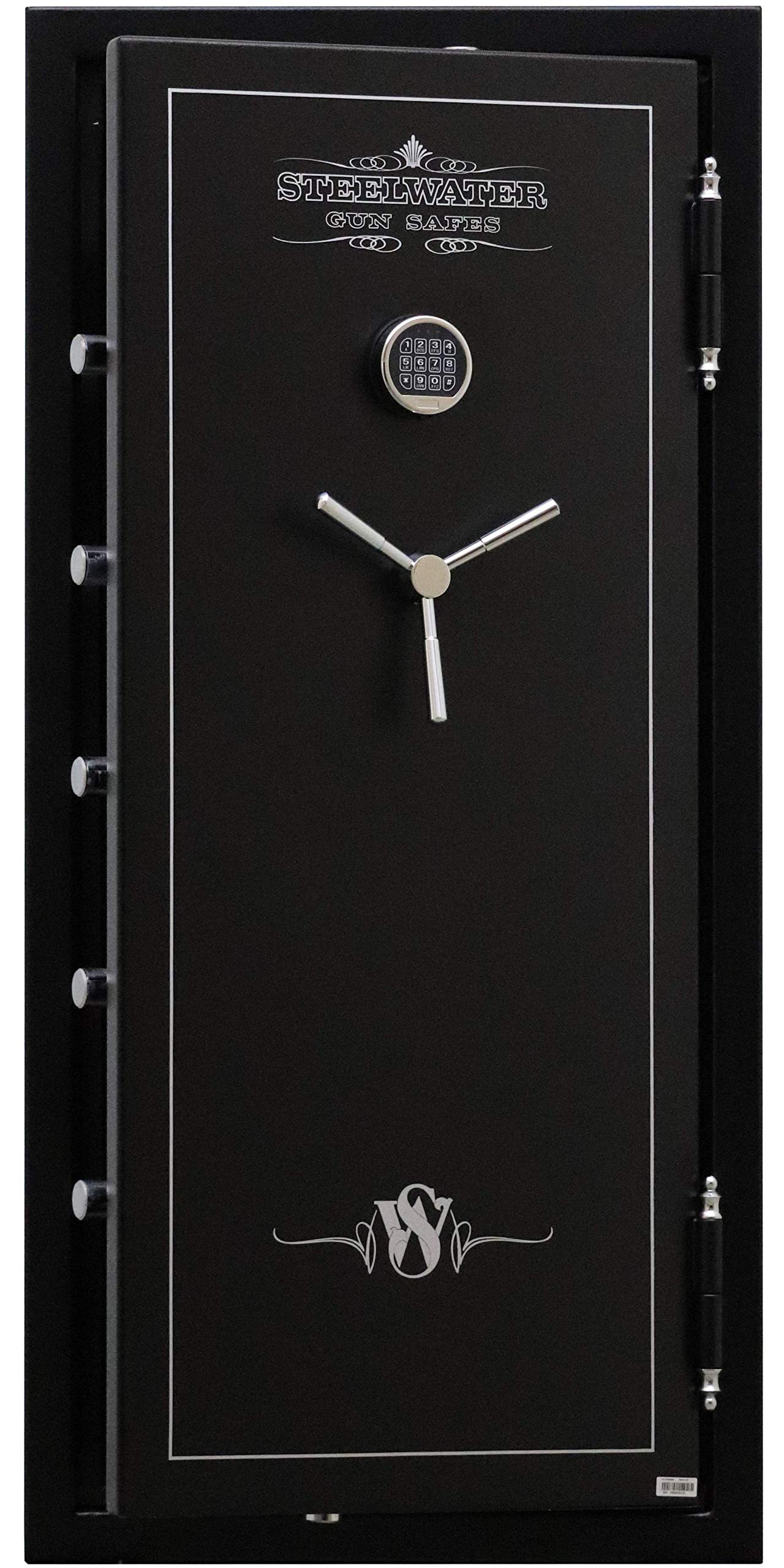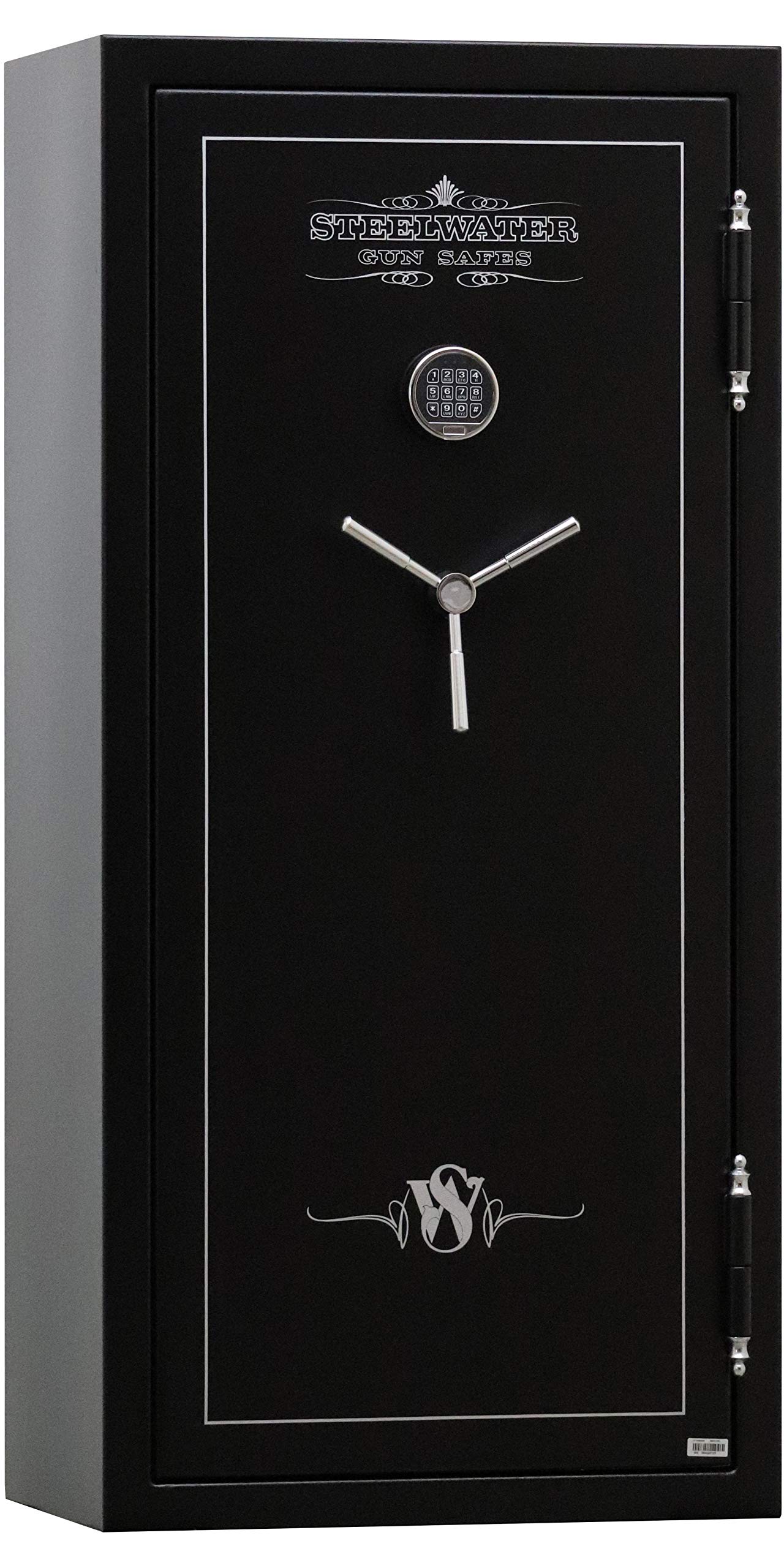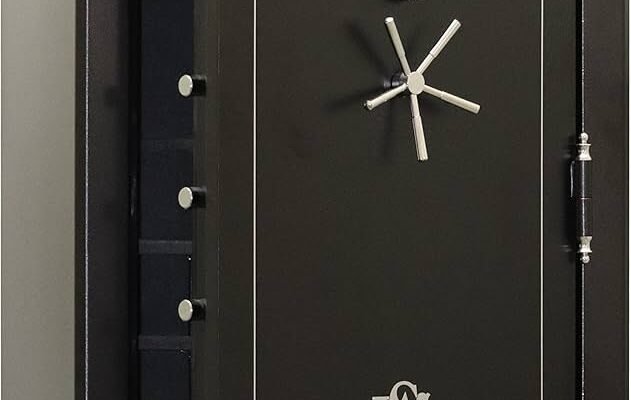If you’re shopping for a serious safe, weight matters. I help homeowners and shop owners spec, move, and install safes, and one of the first questions they ask is simple: how much does a Steelwater gun safe weigh? The short answer is that Steelwater safes range from roughly 300 pounds for compact models to about 1,000 pounds for large, 120-minute fire-rated units. Your final weight depends on size, steel thickness, fireboard layers, and add-ons. In this guide, I’ll break it down, share real-world tips, and help you choose with confidence.

Source: www.amazon.com
What Determines The Weight Of A Steelwater Safe?
Several design choices drive the weight of a Steelwater gun safe. Think of weight like a layered shield. Each layer adds protection and pounds.
- Steel gauge and door thickness: Thicker steel and reinforced doors add major weight and security. Heavier doors resist prying and drilling better.
- Fire rating and insulation: More fireboard layers increase weight. A 120-minute fire rating is heavier than a 60-minute rating.
- Safe size and capacity: Taller, deeper, and wider cabinets for 20, 28, 39, or 45 long guns weigh more.
- Locking bolts and hardware: Larger boltwork, hardplates, and relockers add dense mass.
- Interior features: Door organizers, shelves, lighting, and dehumidifiers add a little, but the bulk comes from steel and fireboard.
- Accessories and packaging: Pallets, foam, and shipping crates increase “shipping weight” beyond “net weight.”
Pro tip: Weight is a security feature. All else equal, heavier often means stronger and more resistant to basic attacks.

Source: www.amazon.com
Typical Weights By Popular Steelwater Models
Steelwater publishes specs for each model. Actual numbers vary by year and configuration. Use the ranges below as a practical guide, then confirm on the current spec sheet before you buy.
- Compact/entry heavy-duty (about 12–16 long guns, 60-min fire): Roughly 300 to 380 pounds. Good for closets or small rooms.
- Mid-size heavy-duty (about 20–28 long guns, 60-min fire): Roughly 450 to 600 pounds. Common choice for most homes.
- Large heavy-duty (about 32–39 long guns, 60-min fire): Roughly 600 to 750 pounds. Needs careful planning for stairs and floors.
- Extreme Duty 120-minute fire series (about 22–45 long guns): Roughly 750 to 1,000+ pounds. Thick steel, more fireboard, heavier doors.
- Office/document and specialty models: Usually 300 to 600 pounds, depending on fire rating and steel.
Examples you’ll see in the market:
- A mid-size heavy-duty 20-gun model often lands near 450 to 500 pounds.
- A larger 39-gun heavy-duty model often lands near 650 to 700 pounds.
- A 120-minute 45-gun extreme-duty model can push 900 to 1,000 pounds.
Always check the product page and manual for both net and shipping weight. The shipping weight is what the freight truck will deliver. It includes pallet and packing materials.

Source: www.amazon.com
Why Weight Matters: Security, Fire, And Floor Load
Weight isn’t just a number. It affects security, safety, and where you can place the safe.
- Security against theft: A 600+ pound safe, bolted to the slab, is far harder to remove or tip. Heavier doors resist prying and drilling.
- Fire performance: Extra fireboard and sealed doors add weight and give you more time in a fire.
- Floor load and structure: Many homes handle 40 pounds per square foot. A 900-pound safe concentrates load on a small footprint. Spread the load with a platform or place it on a slab.
- Tipping risk: Taller, narrower safes can be top-heavy. Weight low in the cabinet helps stability, but proper anchoring is key.
Quick check: If you’re installing upstairs, consult a structural professional, especially for anything over 600 pounds. It’s cheaper than fixing a bowed joist later.

Source: www.amazon.com
How To Weigh Or Verify Your Safe
If you already own a Steelwater or are buying used, here’s how to confirm the weight.
- Check the model tag: The inside door or manual lists the model number. Look up the manufacturer’s spec page for the official weight.
- Compare net vs shipping weight: Expect shipping weight to be 30 to 80 pounds higher due to the pallet and packaging.
- Use a scale method: For on-site checks, slide two low-profile automotive scales under the front edge, then the back edge, and add the readings. Do this only with proper equipment and helpers.
- Measure fireboard and steel: Thicker doors and walls usually confirm the heavier spec. Don’t drill or damage your safe to check.
Tip: If the safe feels “lighter than listed,” make sure shelves and door organizers aren’t removed. Those small items add up.

Source: www.amazon.com
Moving And Installing A Heavy Steelwater Safe Safely
I’ve moved hundreds of heavy units. Respect the weight. Plan the path. Use the right tools. Here’s the checklist I follow.
- Tools: Heavy-duty appliance dolly with straps, stair-climbing dolly for steps, pry bars, moving blankets, and steel-reinforced ramps.
- Team: At least three adults for 600+ pounds. Four for 800+ pounds. Assign one lead spotter.
- Path prep: Remove doors from hinges if possible to reduce weight and balance. Take off shelves and contents. Protect floors with plywood sheets.
- Tipping and balance: Keep the center of gravity over the dolly wheels. Move slow. Communicate every step.
- Anchoring: Use concrete wedge anchors on slab floors. For wood floors, locate joists and use lag shields rated for the load. Follow the manufacturer’s anchor size and torque guidance.
Safety first: Gloves, boots, and patience prevent injuries. A professional safe mover is worth it for anything over 600 pounds or any staircase.
Real-World Lessons From The Field
A few personal notes to help you avoid common mistakes.
- Weight surprises: A “500-pound” safe can feel like 700 when you hit stairs. Stairs change leverage. Budget extra help.
- Door removal: Many Steelwater doors lift off the hinges when opened at 90 degrees. Removing the door can shave 80 to 150 pounds and makes tight turns easier.
- Floor deflection: I once saw a large 120-minute unit on a second floor cause drywall cracks below due to deflection. We added a support post in the basement and solved it. Plan the load path.
- Anchor all four corners: Two anchors help, but four give you the best resistance to prying and tipping.
- Test the boltwork: Before final anchoring, cycle the lock and bolts 10 times. Make sure nothing binds after placement.
These small steps make heavy safes feel manageable and safe to live with.
Cost And Shipping Considerations
Weight shapes the total cost from checkout to installation.
- Freight class: Heavier safes cost more to ship. Curbside delivery is common. Inside delivery or stair carries cost extra.
- Liftgate service: Needed if you don’t have a dock or forklift. This adds a fee but is worth every dollar for heavy units.
- Insurance and returns: Verify coverage for freight damage. Inspect on arrival and note any damage on the bill of lading.
- Installation budget: Factor anchors, labor, and floor protection into your total cost. Heavier safes often save money in the long run through better security.
Plan the logistics early. It keeps your project on schedule and on budget.
Frequently Asked Questions Of How Much Does A Steelwater Gun Safe Weigh?
Do Steelwater Gun Safes Weigh More Than Other Brands?
Steelwater weights are competitive for their steel thickness and fire ratings. A comparable size and rating from many brands will be in a similar range. Heavier usually means more steel or insulation.
What Is The Difference Between Net Weight And Shipping Weight?
Net weight is the safe by itself. Shipping weight includes the pallet, packaging, and any accessories packed with it. Shipping weight can be 30 to 80 pounds higher.
Can I Install A 700-Pound Safe On A Second Floor?
Sometimes, yes, but you need to evaluate the floor structure, span, and load path. Place it near a load-bearing wall, spread the load with a platform, and consult a structural professional.
How Much Does A 20-Gun Steelwater Safe Typically Weigh?
Most 20-gun heavy-duty models land around 450 to 500 pounds. Confirm the exact weight on the current product spec sheet.
How Much Does A 120-Minute Fire-Rated Steelwater Safe Weigh?
Expect roughly 750 to 1,000+ pounds depending on capacity and steel thickness. The extra fireboard and reinforced door add substantial weight.
Will Removing The Door Help When Moving?
Yes. On many models, removing the door can reduce 80 to 150 pounds and make handling safer. Protect the hinges and reinstall carefully.
Should I Bolt Down A Heavy Safe?
Absolutely. Even a 700-pound safe can be shifted or tipped with leverage. Anchoring improves theft resistance and stability.
Conclusion
Steelwater gun safes range from about 300 pounds for compact models to around 1,000 pounds for large, 120-minute units. That weight reflects real protection: thicker steel, stronger doors, and better fire performance. Plan for the weight, verify the specs, and install it right.
If you’re choosing a model today, match weight to your security needs, your floor’s capacity, and your moving plan. Measure your path, line up the right tools or a pro mover, and anchor it in place. Ready to pick the perfect safe? Explore current Steelwater specs, compare fire ratings, and leave a comment with your room layout for tailored advice.
Watch This Video on How much does a Steelwater gun safe weigh?



